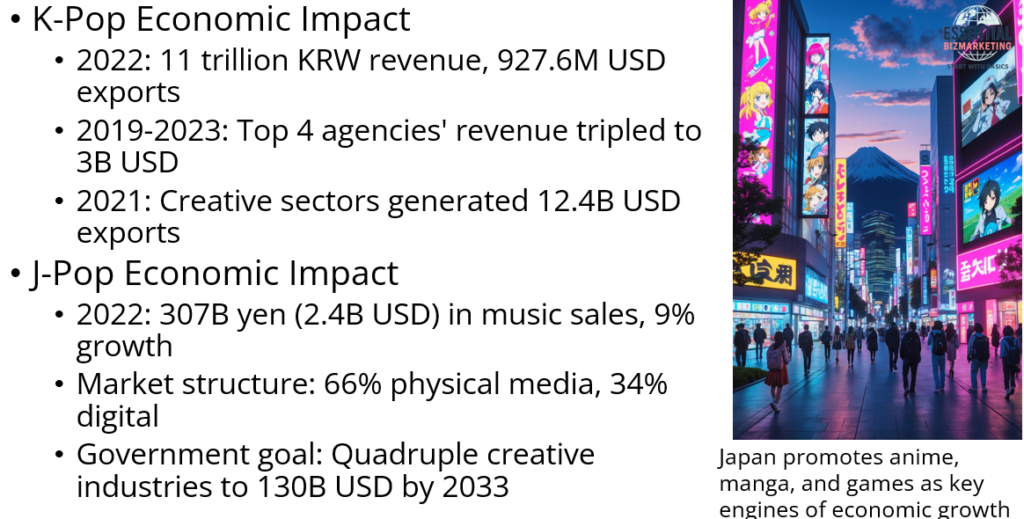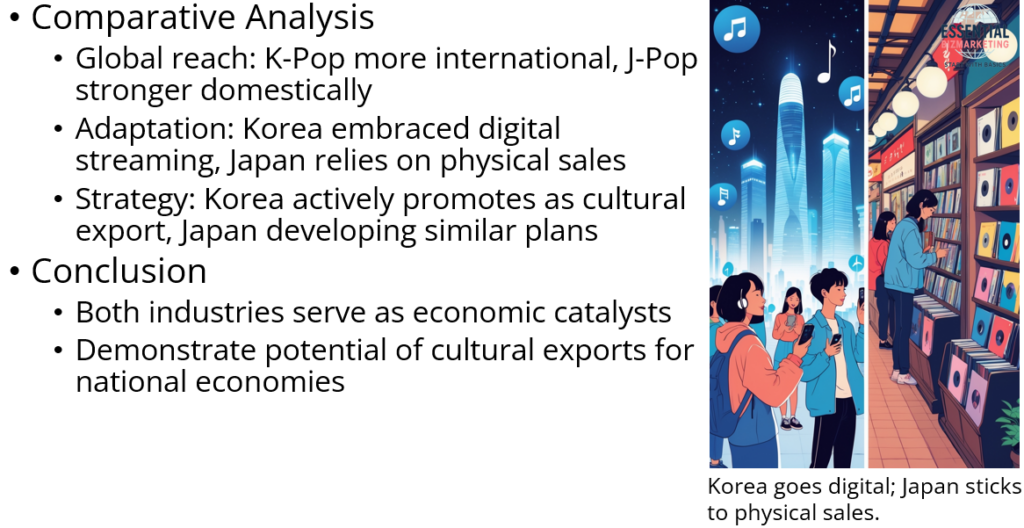Introduction: The Cultural Powerhouses of Asia

South Korea and Japan have established themselves as global cultural influencers through their respective music industries, K-Pop and J-Pop. These genres have not only shaped global music trends but have also significantly contributed to their national economies. This analysis examines how the K-Pop and J-Pop industries have impacted the economic growth of South Korea and Japan, respectively.
Economic Contributions of the K-Pop Industry in South Korea
The K-Pop industry has emerged as a substantial economic force in South Korea. In 2022, the South Korean music industry, encompassing K-Pop, achieved a record-breaking sales revenue of approximately 11 trillion KRW, with an export value around 927.6 million USD. This growth is attributed to various revenue streams, including album sales, digital downloads, streaming platforms, and live events.
Major K-Pop agencies have experienced remarkable financial growth. Between 2019 and 2023, the combined revenue of the four largest Korean music agencies nearly tripled to approximately 4 trillion KRW (3 billion USD), with operating profits reaching 600 billion KRW (450 million USD).
The global success of K-Pop acts, notably BTS, has further amplified South Korea’s cultural export revenues. In 2021, South Korea’s creative sectors, including K-Pop, generated 12.4 billion USD in export revenue, surpassing traditional exports like consumer electronic equipment, which stood at 4.7 billion USD.
Economic Contributions of the J-Pop Industry in Japan

Japan’s music market remains one of the largest globally. In 2022, the country’s recorded music production and digital music sales reached 307 billion yen (approximately 2.4 billion USD), marking a 9% increase from the previous year. This growth was primarily driven by a 17% increase in digital music sales, totaling 105 billion yen (808 million USD).
Despite global trends favoring digital consumption, Japan’s music industry continues to rely heavily on physical media. In 2022, physical media sales accounted for about 66% of the market, while digital distribution comprised approximately 34%. This preference for physical formats has sustained revenue streams from CD and DVD sales.
The Japanese government has recognized the potential of its pop culture as a driver of economic growth. Initiatives are underway to position the country’s creative industries, particularly anime, manga, and video games, as key economic contributors, with ambitions to quadruple their global value to 130 billion USD by 2033.
Comparative Analysis: K-Pop vs. J-Pop Economic Impact

Both K-Pop and J-Pop industries have significantly influenced their respective economies, albeit through different trajectories and strategies.
- Global Reach and Export Revenue: K-Pop has achieved substantial international success, leading to significant export revenues and global recognition. In contrast, while J-Pop maintains a robust domestic market, its global influence is comparatively limited.
- Industry Adaptation and Consumption Trends: The South Korean music industry has effectively adapted to digital consumption trends, leveraging streaming platforms to reach a global audience. Conversely, Japan’s music industry continues to rely heavily on physical media sales, which, while profitable domestically, may limit its adaptability in the evolving global digital market.
- Government Initiatives and Cultural Export Strategies: The South Korean government has actively promoted K-Pop as a cultural export, integrating it into the country’s soft power strategy. Japan is now seeking to enhance the global presence of its pop culture, with strategic plans to position its creative industries as significant economic contributors.
- Conclusion: Cultural Industries as Economic Catalysts
The K-Pop and J-Pop industries exemplify how cultural sectors can serve as catalysts for economic growth. South Korea’s proactive approach to globalizing K-Pop has yielded substantial economic benefits and enhanced its international standing. Japan’s J-Pop industry, while maintaining a strong domestic presence, is poised to expand its global influence through strategic initiatives. Both industries highlight the potential of cultural exports in contributing to national economies.
📚 References
Asia Fund Managers. (2022, November 15). K-pop is making billions for South Korea. https://asiafundmanagers.com/kpop-and-economic-impact-on-south-korea/
International Trade Administration. (2023, March 15). Japan music market. https://www.trade.gov/market-intelligence/japan-music-market
Morgan Stanley. (2023, January 10). K-Pop investment potential: Growing global interest. https://www.morganstanley.com/ideas/k-pop-investment-potential
UNCTAD. (2023, February 20). K-pop blueprint: Drawing inspiration from South Korea’s creative industries. https://unctad.org/news/k-pop-blueprint-drawing-inspiration-south-koreas-creative-industries
GMI Post. (2023, May 5). Japan wants to make its pop culture a top global export. https://gmipost.com/japan-wants-to-make-its-pop-culture-a-top-global-export/
📁 Start exploring the Blog
📘 Or learn more About this site
🧵 Or follow along on X (Twitter)
🔎 Looking for sharp perspectives on global trade and markets?
I recommend @GONOGO_Korea as a resource I trust and regularly learn from.
